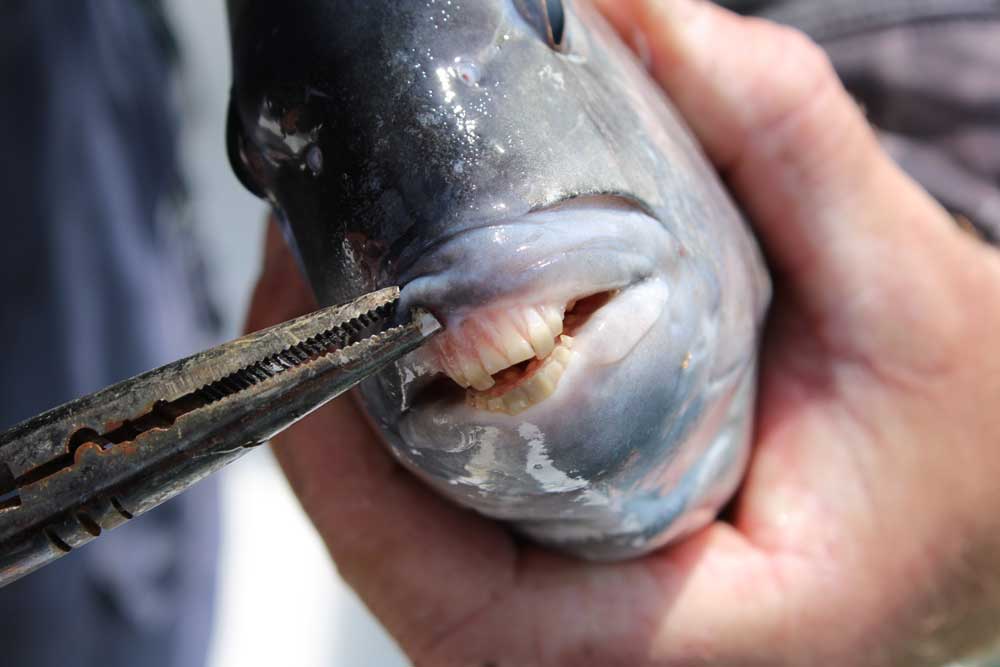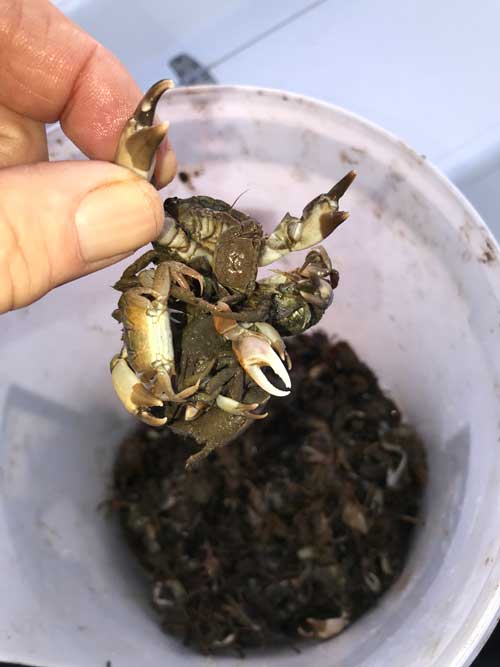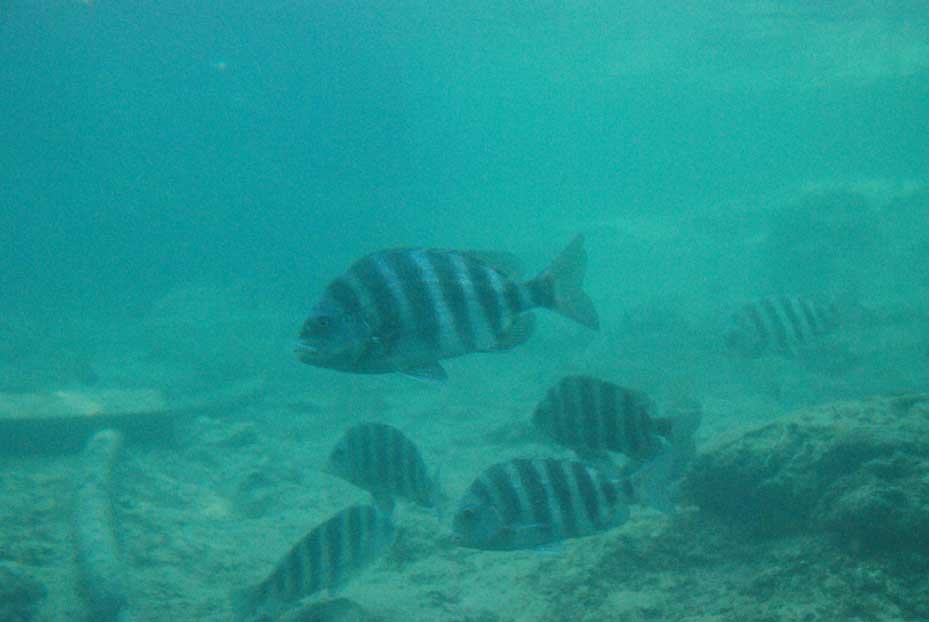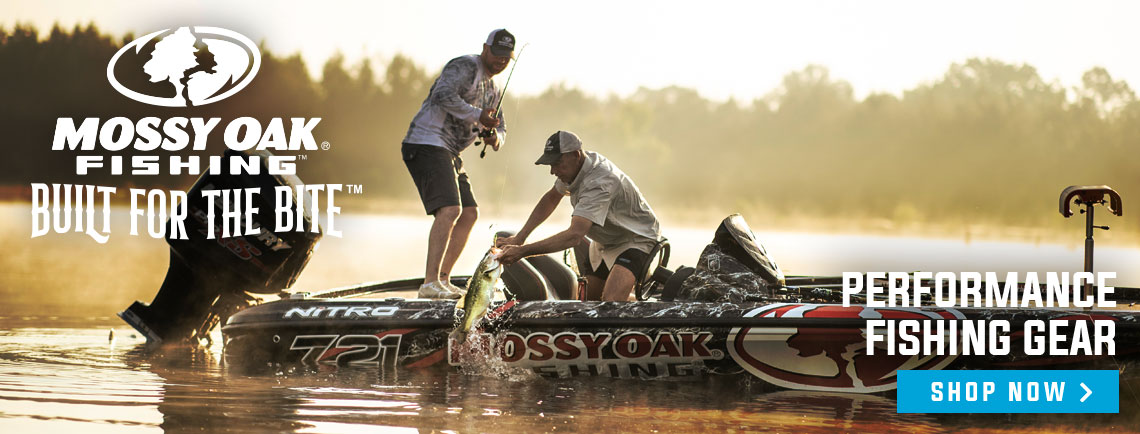Phillip Gentry

Anglers familiar with coastal fishing around the eastern, southern and Gulf of Mexico states are more than familiar with sheepshead. Often dubbed “panfish of the sea,” sheepshead are readily available to anglers fond of fishing structure in the estuaries, bays, harbors and waterways where the fish reside, particularly during the summer seasons and have salvaged many a fishing trip when redfish, trout or flounder were not in the mood to bite.
Two features make sheepshead easily recognizable — the first being bands of dark stripes against a silvery white body and the second being a mouth full of almost human looking teeth, albeit in bad need of a good dentist. These two elements have also garnered the fish the handle of “convict fish” because of the striped uniform and the teeth used to pick hooks clean with little or no notice given to the angler above.
Fishing for sheepshead during the winter was relatively unheard of as little as two decades ago. One reason is a lull of recreational anglers to the coast in cooler months and the other is these fish migrate out, although not all at the same time, to gather and eventually spawn on deepwater structure during the winter.
The resurgence of artificial reef programs in many southeastern states has helped foster a wintertime fishery for sheepshead that is, frankly, much better than most of their spring, summer and fall venues — if the weather cooperates.

Sheepshead are prolific spawners and will do so during a general 12- to 14-week period ranging the first of January to mid-March, depending on the locale. As inshore waters cool, sheepshead will travel out to nearshore reefs, wrecks and bottom structure in a pre-spawn migration. During this time, the hormonal levels and aggressiveness of the fish are heightened, which many believe makes them easier to catch as their pick-pocket style of bite turns a little more defined.
In 2012, Federal fisheries management councils opted to remove sheepshead from federal regulation regarding creel limits and sizes, which were formerly mixed in with an aggregate grouper/snapper complex. State biologists believed since the fish spent the vast majority of its life inside state waters that each state could better manage its own population.
Fishing for winter sheepshead is most effectively done in the classic bottom fishing style where the boat is positioned directly over the top of the structure where sheepshead are holding and lines are dropped vertically. Although there is a recent trend in developing artificial baits for sheepshead fishing, the lion’s share of fish are caught using live bait.

READ NEXT: Winter Crappie Fishing Pattern
While sheepshead will eat a wide variety of baits ranging from invertebrates, clams, shrimp and even small finfish, the number one bait is crabs, particularly fiddler crabs. You can set traps for fiddler crabs, or a couple of guys can catch a bucket full along the marsh. It can be a bit messy, but it doesn't take two guys with quick hands long before they have a bucket full.
During the days of federal management, circle hooks were a requirement for sheepshead fishing, but under state’s control, almost all have dropped that requirement. A size #2 hook up to a 1/0 is the most common used with styles ranging from mosquito hooks to Aberdeen, but all falling within the “J-hook” category. You can find these hooks at any local bait and tackle store, but they are often cheaper online.
The best protection against bait stealing is to use a short leader between six to 18 inches and insert the tip of the hook through the crab’s abdomen until the point barely penetrates the crab’s shell on the other side.
On a tight line with appropriate weight to counter depth and current, maintain contact via a tight line with the weight on the bottom. Any movement or vibration through the line should result in an immediate hookset, which is best done with the reel rather than the rod tip.
Sheepshead are not thought to be line shy and 10- to 20-pound tackle is sufficient to handle sheepshead. Braided line is the preferred main line, owing to the line’s greater sensitivity and durability over monofilament. A short length of abrasion-resistant fluorocarbon line works best for the leader, which should be monitored and changed every few fish or so or anytime a hook fish or hang-up results in the line making hard contact with structure.
Winter sheepshead tend to range a little heavier than in the summertime where a 15-inch, 2- to 3-pound fish tends to be the average. On their winter pre-spawn and spawning aggregates, sheepshead may average from four to nine pounds with a few specimens — which can live as long as 25 years — topping the 10-pound mark.
Sheepshead are great eaters and are known as the poor man's lobster. Anglers will find the better-tasting fish weigh under seven pounds. There is a lot of meat on a sheepshead, and it's tempting to start filleting your fish as soon as you're back at the dock. The result is much better if you take the time to let the sheepshead bleed out first.

Since the sheepshead is known as a poor man's lobster, using sheepshead in a lobster roll recipe is very popular. Start with the FIRM white flesh of the filet. Poach it in saltwater, but don't let the filet get mushy. Remove the white, flaky filets and drain them on paper towels. Sprinkle some salt over them and set them in the refrigerator overnight after they have cooled.
Next, it's time to make the filling for the lobster roll. It's really simple. There is no need to make this difficult. Start with a quarter cup of mayonnaise, one tablespoon of mustard, one stalk of celery, a teaspoon of cider vinegar and a teaspoon of smoked paprika. Stir the ingredients into a large mixing bowl. Break the filets into chunks and add them to the bowl. Gently mix it together, and you are ready to eat. This lobster roll mixture is best if served on buttered hot dog or hoagie buns. That's all there is to it. Quick and easy and sure to be a family favorite.
From catching bait to serving lobster rolls, you are now ready for your next sheepshead fishing trip. As you can see, there is nothing complicated about fishing for sheepshead. There is also nothing more fun, more easy or more delicious than fishing for cold water sheepshead. You will soon learn why they call them the poor man’s lobster.































